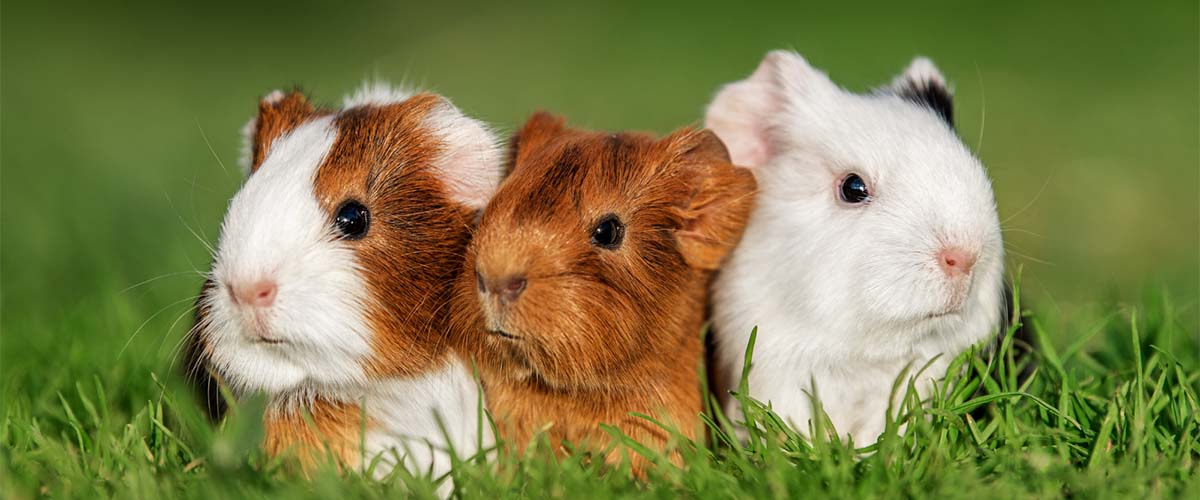Are hamsters good pets?
Hamsters can make great pets if you’re looking for a low-maintenance, small companion:
- They have a typical lifespan of two to three years and like to live alone, away from other hamsters.
- They aren’t the cuddliest creatures but are entertaining to watch as they run about and explore.
- They need a large living space with deep bedding for burrowing and lots of enrichment.
- They tend to sleep during the day and are active in the evenings/at night. They require gentle handling and may bite if they feel threatened.
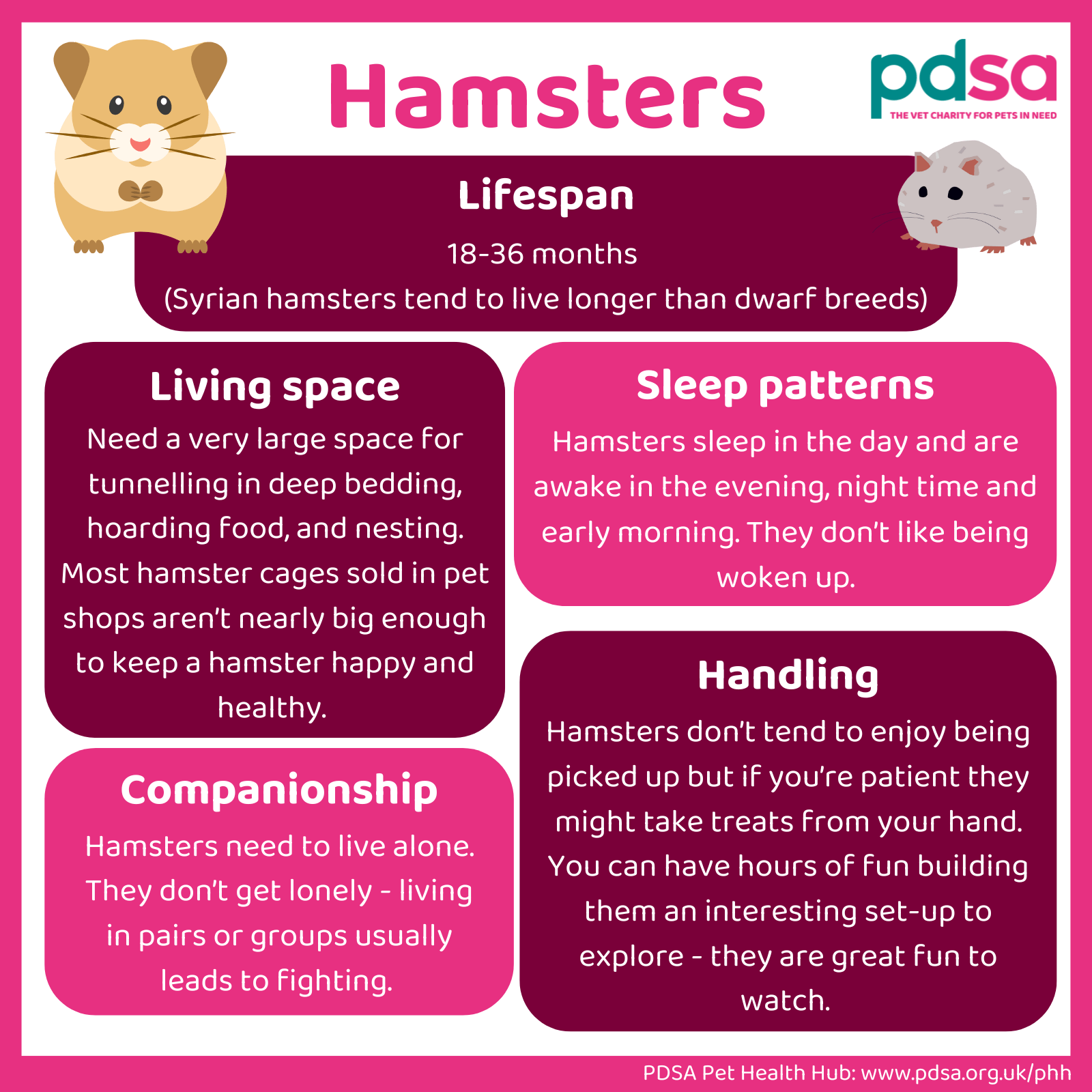
Do hamsters need to live with other hamsters?
Hamsters do not need to live with other hamsters. Most hamster species are solitary animals and prefer to live alone. They don’t get lonely or need a friend, and in fact, keeping them together can often lead to fighting, stress, and injury. If you want to keep more than one hamster, house them separately to ensure their safety and well-being.
- Syrian hamsters and Chinese hamsters live alone in the wild, only encountering others for mating or territorial defence. If they meet, they will fight, leading to injury or possibly even death.
- Russian dwarf hamsters live in small colonies in the wild, however, domesticated Russian dwarf hamsters should not be housed together as dominance issues and fights often occur.
What do hamsters eat?
Hamsters are ‘omnivores’ and in the wild, they eat a mix of plants and insects. The best diet for your hamster is one that’s similar to this, including fresh veg and protein-packed treats like mealworms. The ideal pet hamster diet includes:
Commercial hamster pellets:
- Hamster pellets contain all the nutrients your hamster needs, and each pellet is the same so they can’t pick out their favourite bits and leave the rest.
- If your hamster is bored with their pellets, you can make their meals more appealing by giving them a small amount of muesli-style hamster food. However, it’s best not to feed them muesli-style food mix exclusively because they are likely to eat the bits that are high in sugar and leave the bits that are high in fibre. This can cause dental problems and obesity.
Small amounts of fresh fruit, vegetables, and herbs:
- A small daily portion of fruit, veg and herbs is great for adding variety to your hamster’s diet – just a teaspoon or two a day will do.
- Always give a variety, and wash them before feeding to your hamster.
- Avoid overfeeding sugary fruit/veg as this can lead to health problems such as obesity or diabetes (Russian Dwarf hamsters are particularly prone to diabetes).
- Check out the image below to find out which fruit, veg and herbs are safe for hamsters.
- For more information on the specifics on what treats are safe for hamsters, read our FAQs.
Timothy hay:
- This special variety of hay is full of fibre and ideal for small pets. It also helps keep their teeth healthy.
- You can buy Timothy hay in pet shops or our online pet store.
Occasional treats:
- Hamsters like the occasional treat such as nuts, small pieces of boiled egg, or mealworms.
Things to chew and gnaw:
- Hamsters love to chew and gnaw on things. It’s a natural behaviour that stops their teeth from getting overgrown and prevents them from getting bored.
- They can gnaw on untreated softwood branches but wash them and bake them on a low heat for an hour beforehand.
- Check out the image below for a full list of safe gnawing materials.
Water:
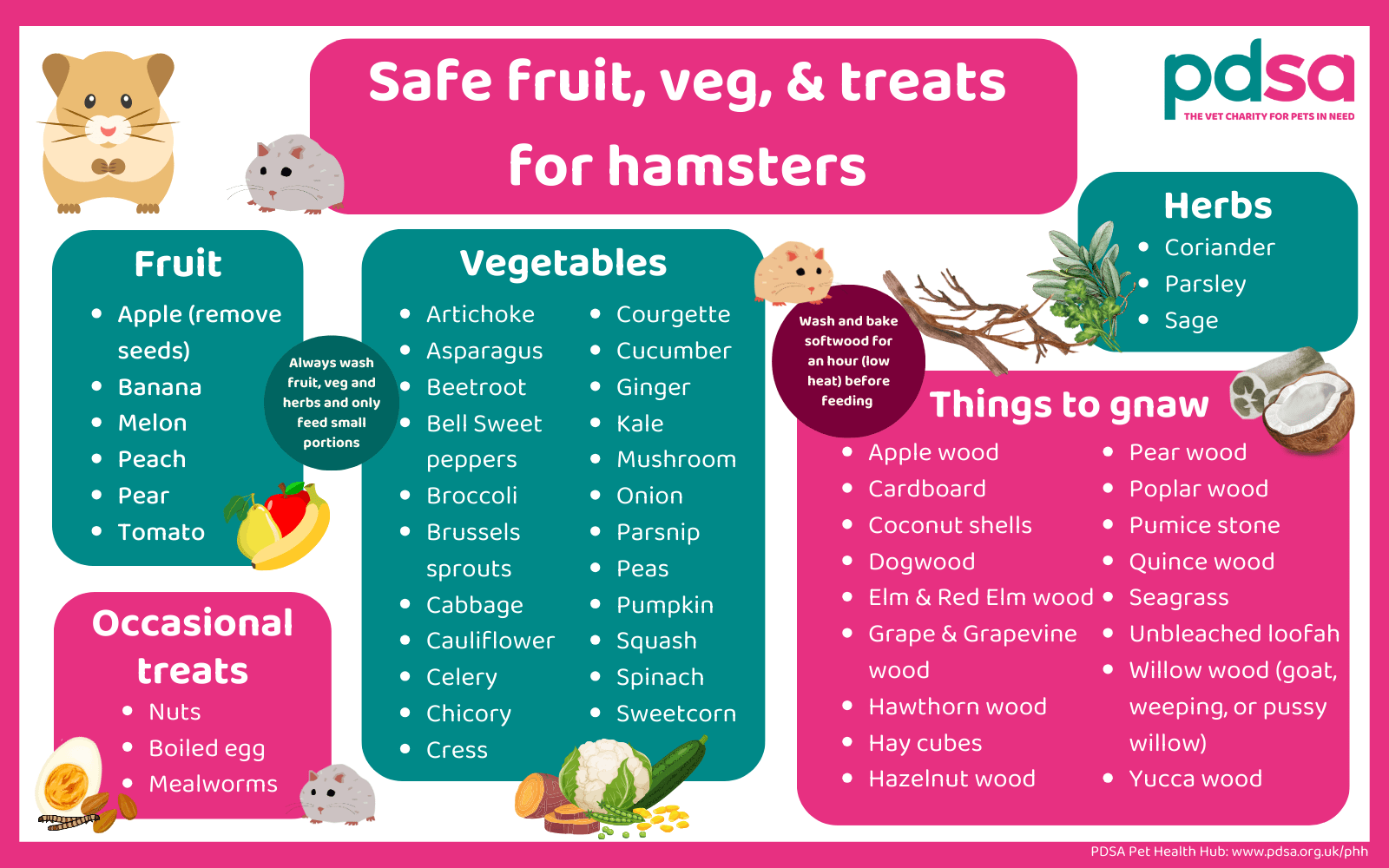
Top tips:
Hamsters in the wild spend a lot of time searching for food, so making them work for their meals is a great way to keep them occupied and prevent boredom. Here are a few fun ideas to try:
- Scatter food pellets around the cage: instead of using a bowl.
- Bury food deep in their bedding: to encourage your hamster to dig.
- Hide hay, pellets, or fresh greens inside paper bags, cardboard tubes, and boxes: Not only will your hamster enjoy the hunt for their food, but they’ll also love chewing on the packaging.
In the wild, hamsters make burrows, climb and walk for miles each day. Most hamster cages sold in shops aren’t big enough to meet a hamster’s most basic needs. We recommend providing them with a much larger space, such as an extra-large cage, glass tank, or homemade enclosure. Make sure it has the following:
- A large floor area with plenty of space for exploring - there isn’t a lot of evidence to say exactly how big a hamster cage should be but the ‘Veterinary Association for Animal Welfare’ (based in Germany) states a minimum cage size of 100x50cm. Note that this is a MINIMUM size but bigger is always better! Single-level, larger cages tend to be better than multi-level, tall cages, as hamsters have poor eyesight and can easily fall from heights.
- A secure lid and doors – hamsters are fantastic escape artists!
- Can accommodate at least 25cm (10 inches) of bedding for burrowing, sleeping and storing food – read about suitable bedding for hamsters below.
- Nest boxes to sleep and hide in – read about nest boxes below.
- Toys to keep them entertained – read about hamster enrichment below.
Where to put your hamster’s home
Make sure your hamster’s cage is positioned somewhere:
- Quiet, calm, and away from anything noisy such as the TV or washing machine - noise and vibrations are stressful for hamsters.
- Kept at a steady temperature between 18-21°C and away from draughts and direct sunlight. If your hamster’s cage gets too hot, they won’t be able to escape and could develop heatstroke. If it gets too cold they might slip into a dangerous survival state, similar to hibernation but called ‘torpor’.
Nest boxes
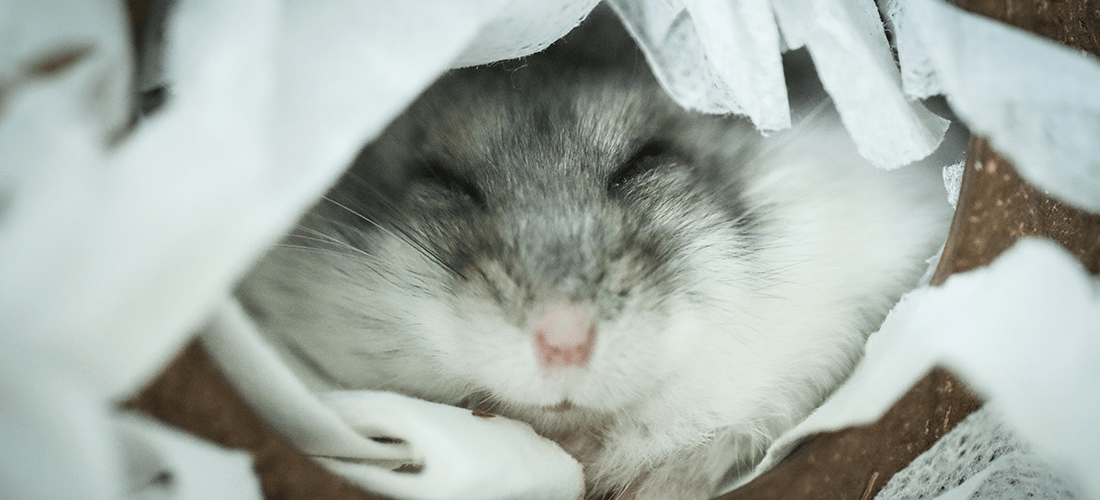
Hamsters spend most of the day asleep, so it’s really important that they have a selection of peaceful places to hide and rest in. They might choose to sleep in their burrows, but it’s important to provide them with nest boxes as well. Nest boxes need to be:
- Hidden - in the wild, hamsters are hunted by other animals so their natural instinct is to sleep out of sight. Small cardboard boxes, ceramic pots or multi-chambered hamster-safe wooden hides are ideal for this.
- Padded with nesting material - it’s best to put the bedding outside of the nest box so your hamster can fill the nest box themselves - read more about nesting materials below.
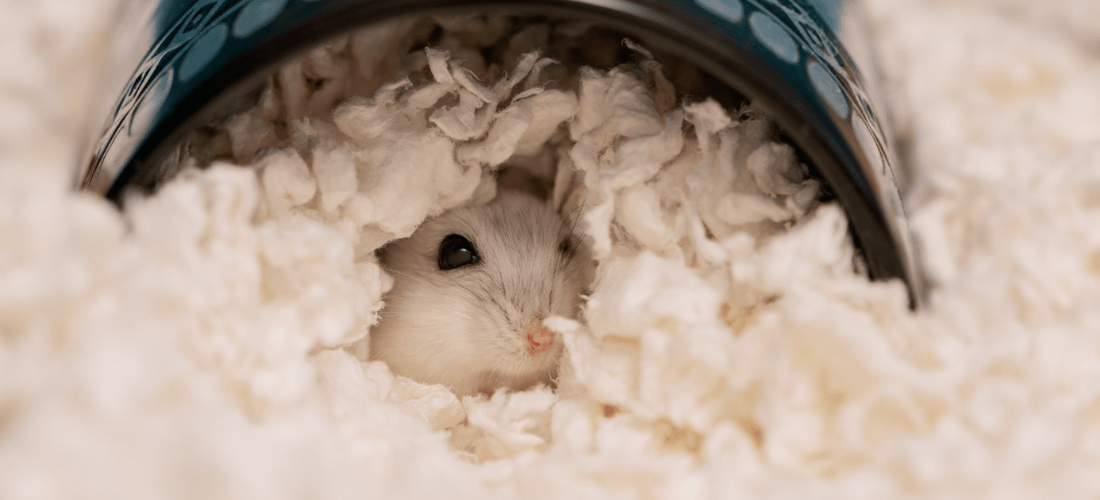
Hamsters need a deep layer of bedding (no less than 25cm/10 inches) so they can burrow like they would in the wild. They use their burrows for sleeping, hiding and storing food so it’s also important to use a material that holds its structure.
Safe hamster bedding
- Paper-based – can be used on its own or with other types mixed in.
- Aspen, spruce or hemp – similar to sawdust/wood shavings but made from hardwood and dust-free. However, these aren’t good at supporting burrows, so you’ll need to mix in some paper-based bedding for extra stability.
- Toilet paper – the cheaper the better because thick toilet paper can cause gut blockages if eaten, and make sure it’s unscented.
- Soft hay – this is a great addition to any of the bedding suggested above, and will help add extra structure and stability to your hamster’s burrows.
- Soil – soil can be used to add a natural feel to your hamster’s home. Make sure to use organic (fertilizer and chemical-free) soil marked as safe for pets.
Unsafe hamster bedding
Some beddings marketed as ‘suitable for hamsters’ are unsafe, such as:
- Wood shavings and sawdust – very dusty and can cause breathing problems.
- Cotton wool, kapok, bamboo fluff and other ‘fluffy’ beddings – these are often marketed as safe for hamsters but can get wrapped around their legs and cause life-threatening gut blockages if eaten.
- Scented bedding – can irritate your hamster’s airways.
- Shredded newspaper – the ink can be toxic to hamsters.
Hamster toys
Hamsters need plenty of toys to stop them getting bored. Your hamster will love any of the following:
- Tubes and cardboard boxes – to crawl through, hide inside and chew.
- Untreated softwood branches and shelves – for climbing and gnawing.
- Gnawing blocks – to help keep their teeth a healthy length.
- An exercise wheel: Make sure it’s as large and wide as possible. A lot of hamster wheels are too small, forcing the hamster to run with a curve in their back which can cause long-term pain. It also needs to have a solid surface to run on, not slats or bars that your hamster’s legs could get caught in.
- At least 20cm (8″) for Dwarf Hamsters
- At least 30cm (12″) for Syrian Hamsters
How often to clean a hamster cage
Keeping your hamster’s home clean is important for their health. To minimise stress, it’s best to clean their cage when they’re awake.
Daily spot clean
- Remove any wet or soiled bedding.
- Clean food and water bowls/bottles.
- Remove any uneaten food.
Weekly full clean
Small cages typically need a full clean once a week, while larger set-ups may only need it every few weeks.
- Remove all bedding and clean the cage with a pet-safe cleaner.
- Rinse and dry everything thoroughly.
- Put a bit of their old bedding (dry and not soiled) back in with the new bedding so their cage still smells like home.
- Put all nests, toys, and bowls back in their original positions. Hamsters are creatures of habit so they like everything to stay in the same place.
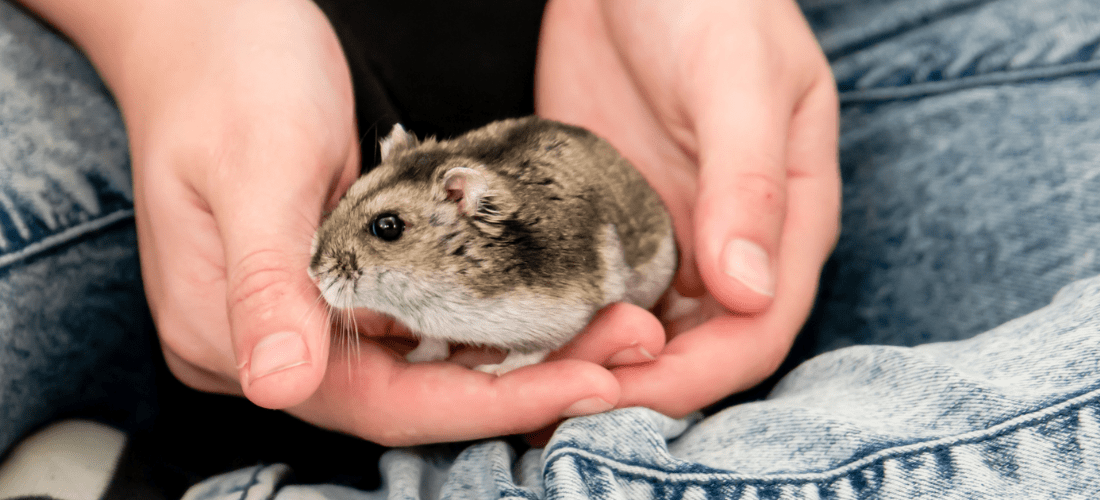
Hamsters are prey animals, so being picked up can be scary for them. However, it’s a good idea to get them used to being around people from a young age so they aren’t too frightened when handling is needed i.e. for vet visits. It’s important to learn how to pick up your hamster properly because they can easily get injured if they’re handled roughly or dropped. To do this:
- Form a cup with both hands on either side of their body.
- Scoop them up securely with both palms and hold them close to your body.
- Sit on the ground while holding them so if they do jump they don’t get injured.
- If your hamster seems frightened, put them back in their cage and feed them some treats/stoke them when they approach you.
- Only try to handle your hamster when they're awake and active, never when they're sleeping as they're likely to be scared and bite you.
- Children should always be supervised when handling hamsters as they need to be handled carefully and can bite. Ideally, we recommend that children don’t hold hamsters but feed them treats and gently stroke them in their cage instead. If you’re looking for a pet that usually enjoys being picked up and held, consider rats or ferrets instead.
Common health problems in hamsters
It’s important to keep a close eye on your hamster for any signs of illness, and if you notice changes in their behaviour or appearance, contact your vet immediately. Here are some common health problems that affect hamsters:
Wet tail (diarrhoea)
Diarrhoea in hamsters, often called “wet tail”, has a few different causes, including bacterial infections, a sudden change in food, stress, or gut parasites. Symptoms of wet tail tend to include diarrhoea, a wet or soiled tail, reduced appetite, lethargy (low energy), dehydration, and sometimes sudden death.
Wounds
Wounds in hamsters are usually caused by fighting with cage-mates or injuries from sharp objects. If you notice a wound on your hamster, check the cage for any potential hazards, separate them from any hamsters they are fighting with, and contact your vet for an appointment.
Abscesses
Abscesses are common in hamsters, often resulting from injuries caused by fighting or sharp objects in the cage. They tend to appear very suddenly as hot, red, painful swellings. It’s best to contact your vet as soon possible if you suspect your hamster has an abscess as they tend to be very painful. Treatment may involve draining, flushing, or surgical removal of the abscess and your hamster may be given antibiotics.
Overgrown nails
Overgrown nails are a common problem in hamsters and can cause pain, problems moving around, and much more serious problems if the nails then grow into the pads. It’s important to trim your hamster’s nails if they become too long but be sure to only cut the white tip of the nail.
Avoid cutting the pink section further up as this bit contains blood vessels and nerves, so if it’s cut it will be sore and cause bleeding. If you’re not confident trimming your hamster’s nails, contact your vet for an appointment.
Alopecia (fur loss)
Various things can cause fur loss in hamsters, including:
- Overgrooming or rubbing against cage bars
- Barbering (fur chewing by cage mates)
- Skin parasites such as mange
- A type of skin cancer called T-cell lymphoma. This is quite common in adult hamsters and causes patchy fur loss, weight loss and low energy
- Ringworm (a fungal infection of the skin)
- Underlying health conditions such as a thyroid problem, nutritional deficiency, adrenal gland tumour, or kidney problem
Overgrown Teeth
Overgrown teeth are common in hamsters because their teeth continuously grow throughout their life, so need to be worn down by gnawing. Overgrown teeth can prevent a hamster from eating, and cause pain, weight loss, and drooling. Hamsters with dental problems may also develop abscesses on their face.
Conjunctivitis
Conjunctivitis (inflammation of the eye) can be caused by bacterial infection, injury, living in a dusty environment, or tooth problems.
Protruding eyeballs
Hamster’s eyes are fragile and can easily pop out of their sockets if they are handled roughly, squeezed, dropped, ‘scruffed’ (picked up using the fur at the back of the neck), or if they have a serious eye infection. Prolapsed eye(s) are an emergency.
Breathing problems
Breathing problems in hamsters often indicate a lung infection or heart disease. Lung disease can cause a weepy nose and eyes, while heart disease often leads to a swollen belly. However, there is a fair bit of overlap between the symptoms of both conditions. For example, both can cause trouble breathing, loss of appetite, lethargy (low energy), and sometimes even sudden death.
Tumours
Hamsters can develop various types of tumours but fortunately, most are benign (non-cancerous). However, it’s always best to have new lumps checked by your vet, because the faster they get a diagnosis and any necessary treatment, the better their prognosis.
- Can I feed my hamsters citrus fruits?
- Which fruits are safe to feed my hamsters?
- What safe vegetables can I feed my hamsters?
- What treats can I feed my hamsters?
- What can my hamster safely chew/gnaw on?
- Do hamsters hibernate?
Can I feed my hamsters citrus fruits?
Generally, hamster owners have been advised against feeding citrus fruits, such as oranges, lemons, or grapefruits, due to their high acidity. However, new research suggests that citrus fruits may not only be harmless to hamsters but could potentially offer some health benefits. The jury’s still out on these fruits, so in the meantime, it may be best to avoid them and stick to safer, more well-established fruits like the ones listed in the image above such as bananas or melons.
Which fruits are safe to feed my hamsters?
There are many treats that you can feed to your hamster in moderation including different fruits, vegetables and herbs. Remember to always wash fruits, vegetables and herbs and to only give small portions.
These fruits are all suitable for your hamster:
- Apple (remove the seeds)
- Banana
- Melon
- Peach
- Pear
- Tomato
What safe vegetables can I feed my hamsters?
Just like with safe fruits, we recommend washing any vegetables you feed your hamsters and only feeding them in moderation.
These vegetables are all suitable for your hamster:
- Artichoke
- Asparagus
- Beetroot
- Bell Sweet peppers
- Broccoli
- Brussel sprouts
- Cabbage
- Cauliflower
- Celery
- Chicory
- Cress
- Courgette
- Cucumber
- Ginger
- Kale
- Mushroom
- Onion
- Parsnip
- Peas
- Pumpkin
- Squash
- Spinach
- Sweetcorn
What treats can I feed my hamsters?
As previously mentioned above, there are a variety of safe fruits and vegetables that you can feed your hamsters. But there are also other occasional treats you can give your furry friends such as:
- Nuts
- Boiled egg
- Mealworms
- Coriander
- Parsley
- Sage
What can my hamster safely chew/gnaw on?
Chewing and gnawing is a natural behaviour for hamsters. It not only helps maintain healthy teeth by preventing overgrowth but also provides mental and physical stimulation, keeping them happy and engaged.
These things are all suitable for your hamster to gnaw on:
- Apple wood
- Cardboard
- Coconut shells
- Dogwood
- Elm and Red Elm wood
- Grape and Grapevine wood
- Hawthorn wood
- Hay cubes
- Hazlenut wood
- Pear wood
- Poplar wood
- Pumice stone
- Quince wood
- Seagrass
- Unbleached loofah
- Willow wood (goat, weeping, or pussy willow)
- Yucca wood
Do hamsters hibernate?
Some species of wild hamsters hibernate for months during the winter. Others, such as Syrian hamsters, may enter a short-term hibernation state called "torpor" if they are exposed to low temperatures. Torpor typically lasts for a few hours to a few days.
Pet hamsters generally do not hibernate or enter torpor because our homes are warm year-round. However, if you suspect your hamster may be in a state of torpor, it's crucial to check that the room temperature hasn't fallen below 20°C. If it has, gradually increase the temperature to help your hamster awaken.
If you are concerned that your hamster may have passed away, you can perform a few checks, such as observing for breathing, gently feeling their chest for a heartbeat, or gently stroking them to see if they twitch their whiskers.
Published: Dec 2024







